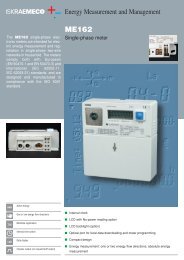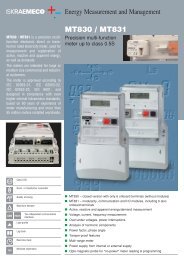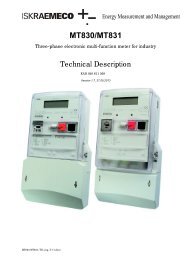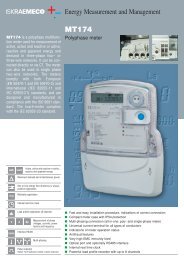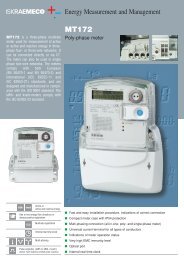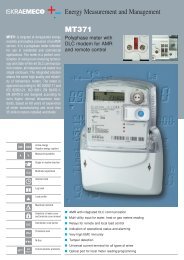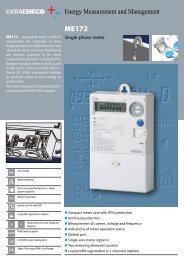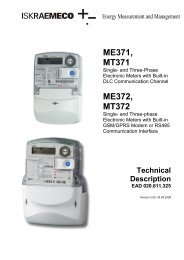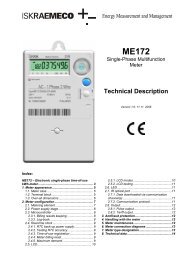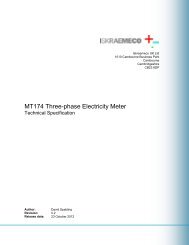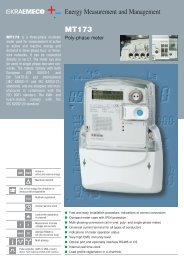ME162 - Technical Description - Iskraemeco UK
ME162 - Technical Description - Iskraemeco UK
ME162 - Technical Description - Iskraemeco UK
You also want an ePaper? Increase the reach of your titles
YUMPU automatically turns print PDFs into web optimized ePapers that Google loves.
<strong>ME162</strong> ─ Electronic single-phase kWh-meter<br />
2.6.4. Error register description<br />
The error register F.F is a hexadecimal value and<br />
generates the following alarms when particular bits<br />
are set to 1.<br />
Bit<br />
Error description<br />
0 Check sum error in energy registers in<br />
EEPROM<br />
1 Check sum error of meter parameters in<br />
EEPROM<br />
2 Check sum error of meter parameters in RAM<br />
3 Check sum error of program code<br />
4 False tariff table<br />
5 Not implemented<br />
6 Not implemented<br />
7 Not implemented<br />
2.6.5. Communication protocol<br />
The communication protocol is IEC 62056-21 (former<br />
IEC 61107), mode C. The communication is asynchronous<br />
half-duplex.<br />
Data format:<br />
1 start bit, 7 data bits, 1 parity bit, 1 stop bit<br />
The entire data block is protected by a control mark in<br />
compliance with the DIN 66219 standard.<br />
After receiving the calling telegram at a 300 baud<br />
data transmission rate,<br />
/ ? Device address ! CR LF or / ? ! CR LF<br />
the meter reveals its identification at a 300 baud data<br />
transmission rate:<br />
/ I S K 5 M E 162 – “Program version”<br />
The meter address refers to the contents of the 0.0.0<br />
or 0.0.1 registers. Then the meter waits for 2 sec. so<br />
that the proposed data transmission rate is confirmed:<br />
ACK 0 5 0 CR LF.<br />
If the proposed baud rate is confirmed, communication<br />
at a 9,600 baud rate follows; if it is not confirmed,<br />
communication at 300 baud continues. The<br />
meter transmits the data telegram:<br />
where<br />
2.7. LED<br />
STX Data ! CR LF ETX BCC<br />
STX: stands for the start of a text;<br />
Data: refers to codes and data<br />
! CR LF: stands for the end of data<br />
ETX: stands for the end of a text<br />
BCC: stands for Block Check Character –<br />
parity check<br />
The meter is provided with a LED on the front plate.<br />
The imp/kWh LED has two functions depending on<br />
the meter mode. In the meter mode it is used for<br />
testing the meter accuracy and blinks with a pulse<br />
rate 1,000 imp/kWh, the pluses width is 40 ms.<br />
LED STATUS INDICATION<br />
Imp/kWh<br />
Blinks<br />
Lit<br />
OFF<br />
Energy is registered. The<br />
pulse rate is proportional to<br />
demand<br />
Voltage applied to the meter,<br />
but load current is lower than<br />
the meter starting current.<br />
No voltage is applied to the<br />
meter.<br />
In the RTC testing mode it is used for testing the RTC<br />
accuracy and blinks with 4096 Hz test frequency (see<br />
item 2.4.2 Testing RTC accuracy).<br />
2.8. Data scroll push-button<br />
There is a Scroll push-button on the meter front side.<br />
Its primary function is to scroll data from the Manual<br />
scroll sequence on the LCD. It should be pressed<br />
again and again for each next data to be displayed.<br />
It also enables data displaying on the LCD when the<br />
meter is in no-power state if such a function was<br />
requested at meter ordering. If no voltage is applied<br />
to the meter and the Scroll pushbutton is pressed, the<br />
first data from the Manual scroll sequence appears<br />
on the LCD and, at the same time, the PD signal flag<br />
is displayed indicating that the meter is in a no-power<br />
state. The LCD remains turned-on for a period of<br />
Manual sequence time-out (i.e. 60 sec.) if the Scroll<br />
pushbutton is not pressed again. After that time the<br />
LCD turns off automatically.<br />
2.9. Tariff Inputs<br />
Optionally the meter can be equipped with one (tworate<br />
meters) or two (3- and 4-rate meters) tariff inputs<br />
that are used for external tariff changeover. If a CS<br />
interface is built into the meter, than only one tariff<br />
input can be built in besides it.<br />
The tariff input control voltage is a phase voltage. The<br />
tariff input is set into logic 1 state if voltage applied to<br />
the tariff input is Ut > 0.8Ur, and is set into logic 0<br />
state if voltage applied to the tariff input is Ut < 0.2Ur.<br />
A combination of voltages applied to the tariff inputs<br />
determines which tariff is valid, e.g.:<br />
Tariff input 13 Tariff input 33 Valid tariff<br />
0 0 T1<br />
1 0 T2<br />
0 1 T3<br />
1 1 T4<br />
On request, a ground of the tariff inputs can be<br />
connected internally to the meter ground.<br />
9 of 14



